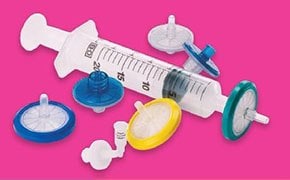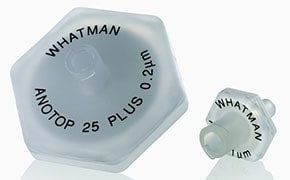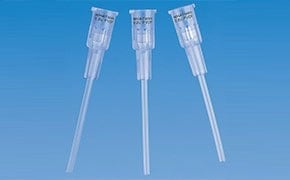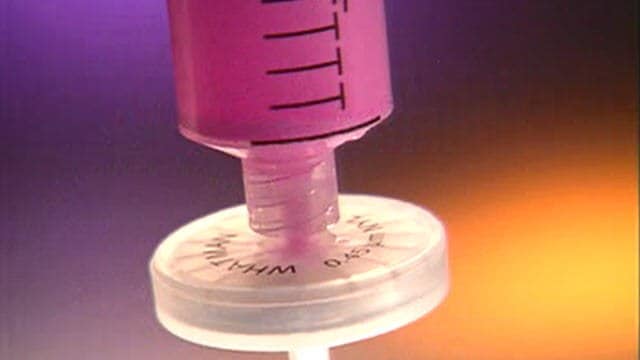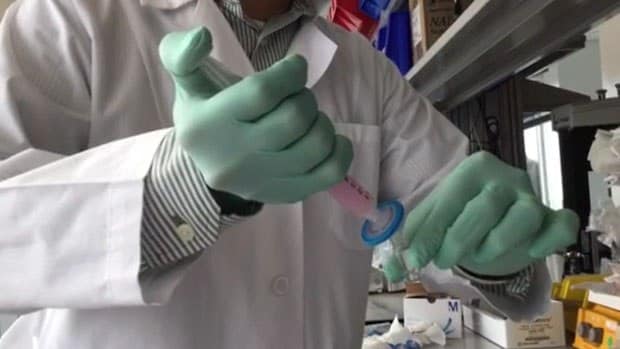Syringe Filters
Syringe filters are single-use, membrane-based devices used for the removal of particulate impurities from liquid and gas samples prior to analysis by methods such as HPLC, ion chromatography, gas chromatography, ICP, and dissolution testing. Proper filtration of samples improves the quality and consistency of analytical results and decreases instrument downtime. Disposable syringe filters are commonly used for fast and efficient filtering. Selection should be by application. Sterile syringe filters are used to sterilize solutions or clarify sterile solutions, while nonsterile syringe filters are used for general filtration and sample purification. Syringe filters are categorized by two essential characteristics – membrane and filter housing. Both characteristics must be compatible with the application and solution being filtered. Syringe filter membranes are matched by composition, filter diameter, and pore size, while syringe filter housings are matched to end applications based on composition and format.
Products
Related Resources
- Millex® Syringe Filters
Choose Millex® syringe filters: sterile, nonsterile formats. Wide membrane, housing options for HPLC, UHPLC, dissolution testing compatibility.
Millex® syringe filters
Featuring reduced sample loss due to minimal hold-up volumes, Millex® syringe filters are ideal for use in a variety of applications including HPLC sample preparation, the filtration of antibiotics and tissue culture additives, and dissolution testing. Our controlled manufacturing process ensures reliable filter performance. Our sterile devices include a certificate of quality. Available with many different membrane and housing options, Millex® syringe filters are compatible with a variety of solvents and sample types.
- Designed for sterile and nonsterile small-volume filtration (1-200 mL)
- Produced with high-quality Millipore® membranes
- Available in 4, 13, 25, 33, and 50 mm diameters
- Minimal hold-up volume reduces sample loss
- Low extractable and low binding membrane options
Whatman® syringe filters
- Whatman® Puradisc® syringe filters combine premium quality and economy and are ideal for quick, efficient filtration of samples up to 100 mL volumes.
- Whatman® Puradisc® Aqua syringe filters are specifically designed for filtration of environmental samples prior to COD and DOC analysis. The membranes used in these devices are prewashed prior to assembly to reduce the organic carbon level.
- Whatman® Uniflo syringe filters are disposable filtration devices for removing solids from liquid samples prior to analyses such as HPLC and UV/Vis spectrophotometry. They are available in variety of membrane choices with 0.2 μm or 0.45 μm pore sizes, feature a polypropylene overmold housing, and include both sterile and non-sterile options.
- Whatman® ReZist® syringe filters are specifically designed to be resistant to organic solvents. These filters are ideal for the clarification of aggressive organic solvents.
- Whatman® Spartan® syringe filters provide reproducible filtration of organic and aqueous solutions for high performance and ultra-high performance liquid chromatography (HPLC and UHPLC) sample preparation. For batch-to-batch consistency, these filters are tested and certified for the absence of UV-absorbing substances at wavelengths of 210 and 254 nm with water, methanol, and acetonitrile.
- Whatman® Roby syringe filters are designed specifically for automated filtration systems. The design of the polypropylene housing ensures smooth transport from the storage turntable to the filtration site.
- Whatman® Anotop® syringe filters feature an inorganic Anopore® aluminum oxide membrane in a polypropylene housing and are specifically designed for the preparation of samples for subsequent ion chromatography and HPLC analysis. These devices ensure very low levels of anion leaching for ion chromatography testing.
- Whatman® GD/X syringe filters are high-viscosity filters that incorporate a prefilter to enable filtration of viscous, dense or otherwise hard-to-filter material with high solids content as in environmental and food analysis samples.
- Whatman® GD/XP disposable syringe filters, a modification of the GD/X line, use a polypropylene prefilter stack, making GD/XP suitable for samples that require inorganic ion analysis.
Corning® syringe filters
HPLC-certified non-sterile syringe filters are available with nylon, regenerated cellulose or polytetrafluorethylene (PTFE) membranes in polypropylene housing for extra chemical resistance. Sterile tissue culture-tested syringe filters are available in PES, regenerated cellulose, or surfactant-free cellulose acetate membranes in either polypropylene or acrylic copolymer housings. The larger 50 mm diameter disc filter has a PTFE membrane and polypropylene housing with hose barb connectors and is ideal for filtering aggressive solvents or gases and applications requiring sterile venting of gases. Because they have a hydrophobic membrane, they are also ideal for protecting vacuum lines and pumps.
Whatman® Mini-UniPrep® Syringeless Filters
Whatman® Mini-UniPrep® Syringeless Filters provide a faster and easier way to remove particulates from samples being prepared for High Performance Liquid Chromatography (HPLC) and Ultra High Performance Liquid Chromatography (UHPLC) analysis. Mini-UniPrep® is a preassembled filtration device consisting of a 0.4 mL capacity chamber and a plunger. The plunger contains a filtration membrane at one end and a pre-attached cap/septum at the other. The plunger is pressed through the sample in the outer chamber and positive pressure forces the filtrate into the reservoir of the plunger. Air escapes through the vent hole until the locking ring is engaged, providing an air-tight seal. Within seconds the Mini-UniPrep® can be placed into any device able to contain 2 mL vials for injection into your instrument. The Mini-UniPrep® device is designed to fit into any autosampler accommodating 12 x 32 mm vials. Alternatively the septum can be pierced with a needle and the sample drawn off for manual injection into an analyzer. Use with standard robotics on HPLC instruments with sensitive needles, allowing for higher throughput. For use in routine HPLC/UHPLC analysis, composite assays, protein precipitation, solubility testing, dissolution testing, and sample filtration.
To continue reading please sign in or create an account.
Don't Have An Account?